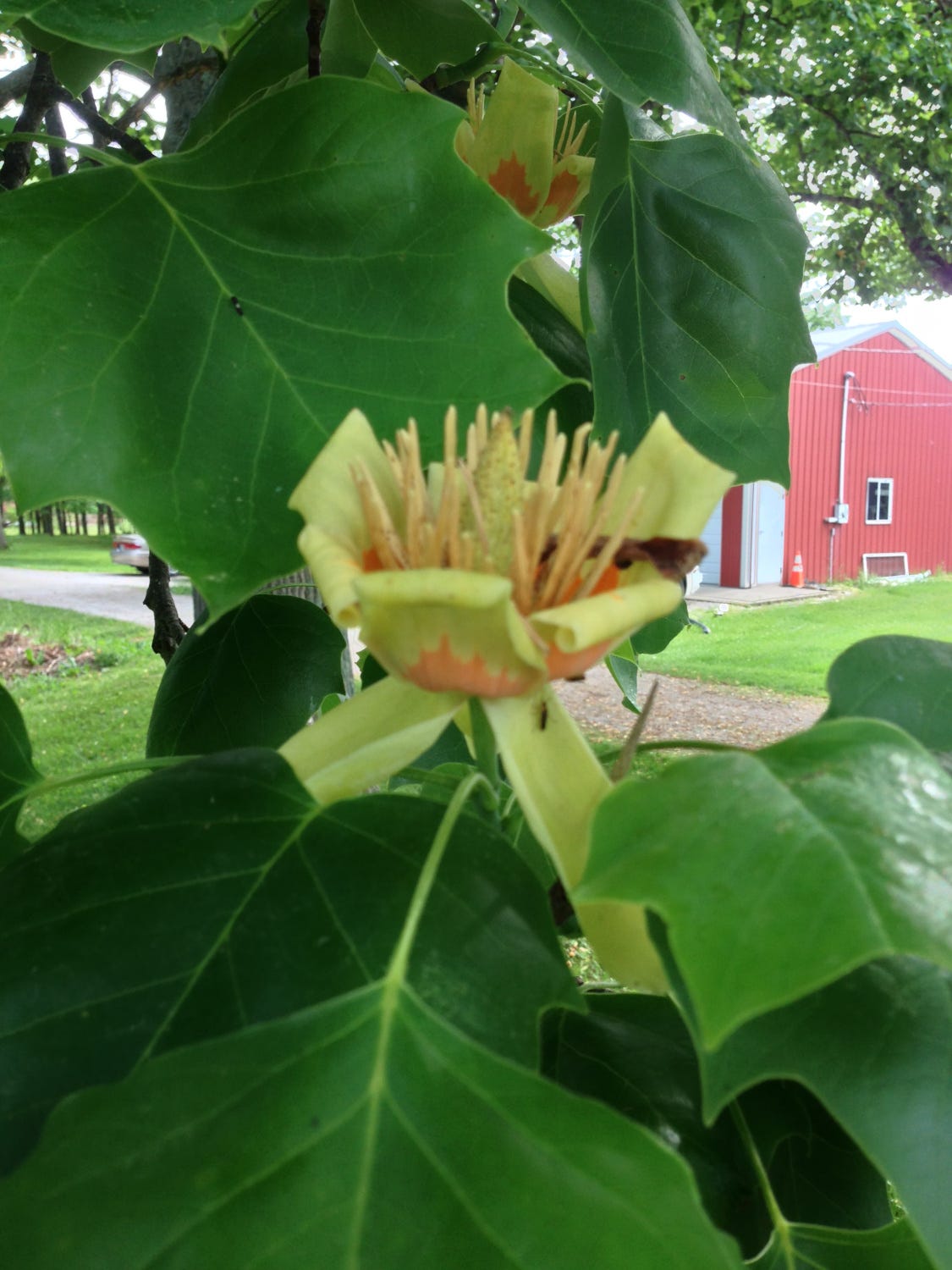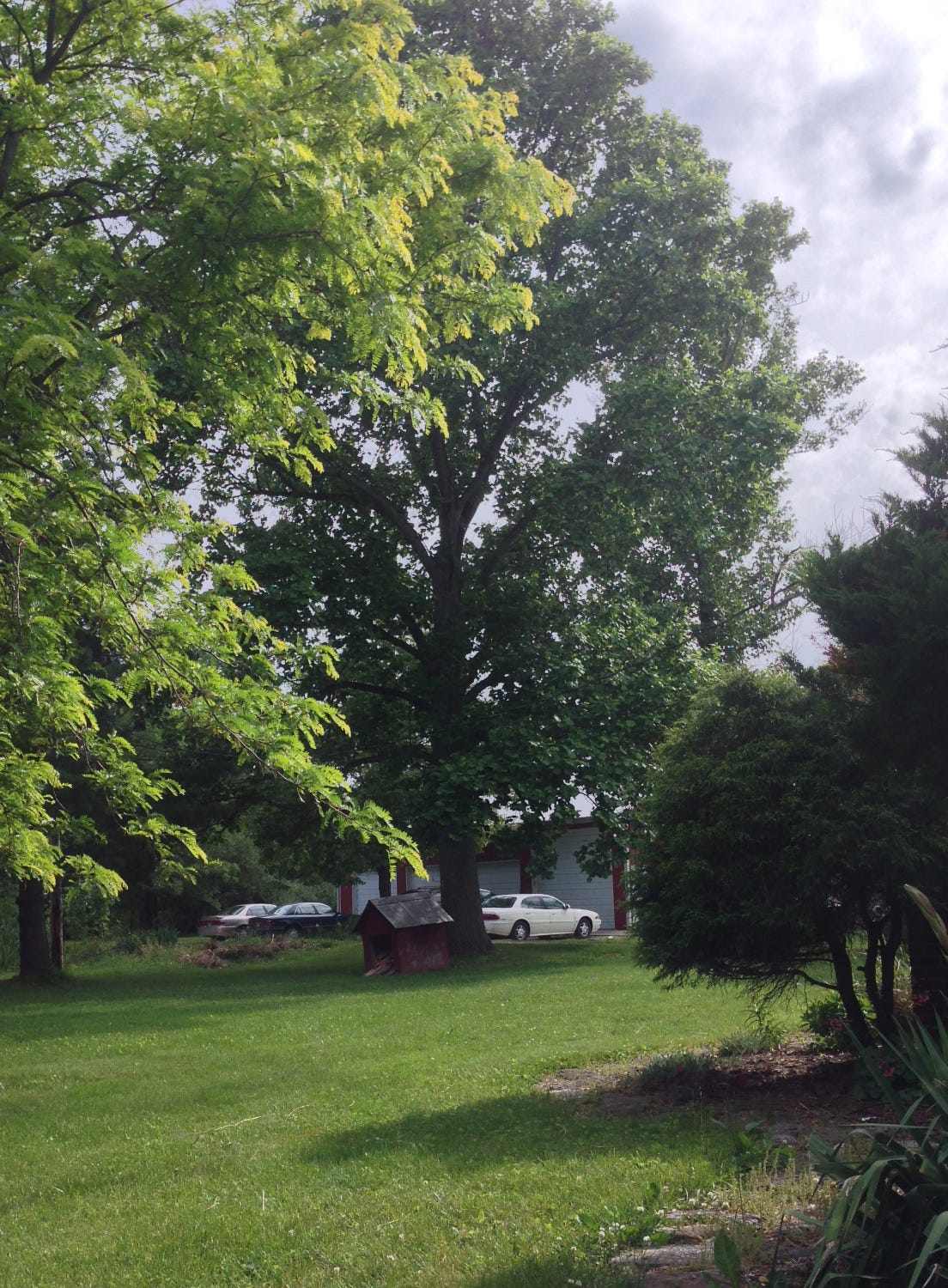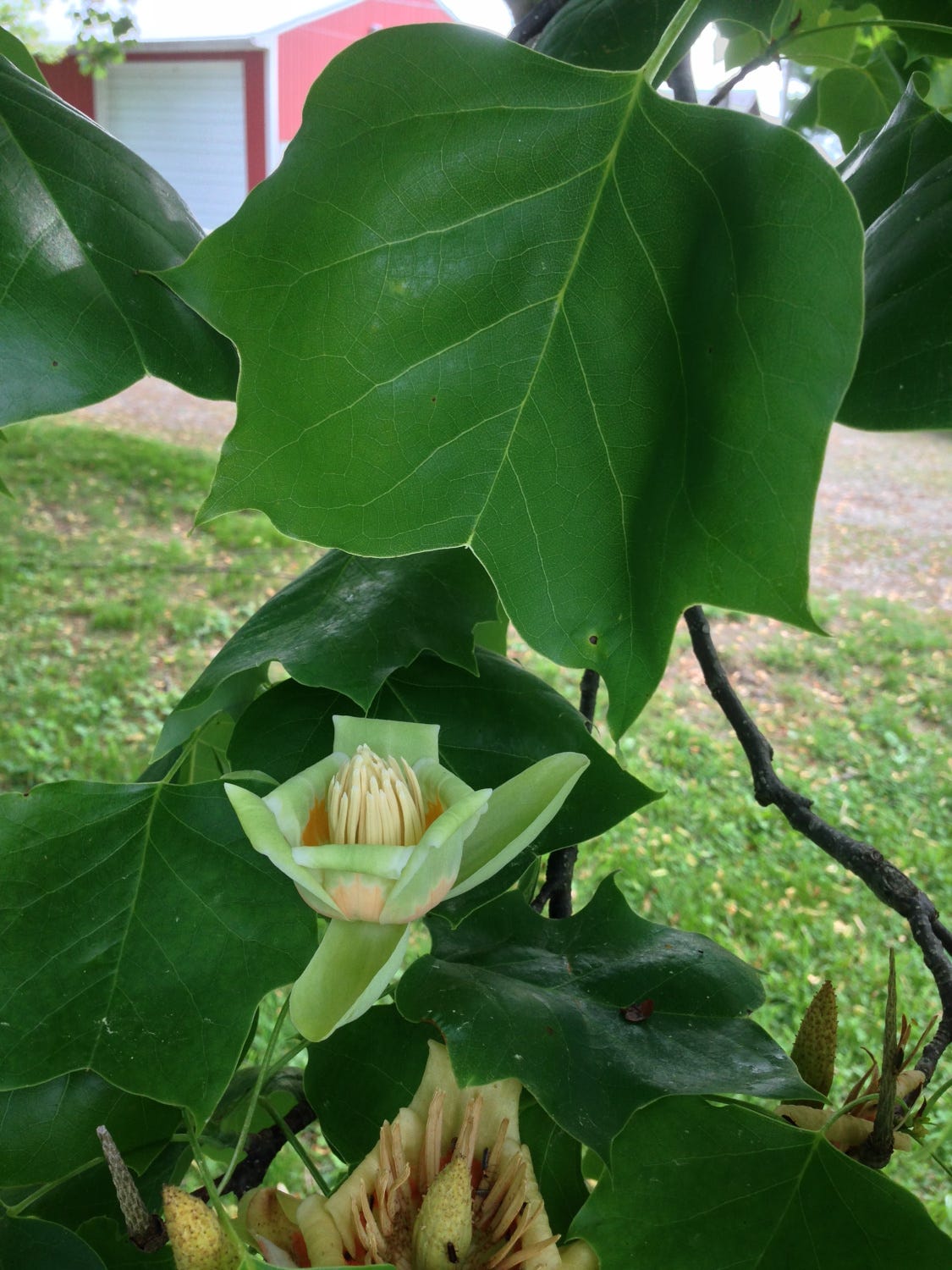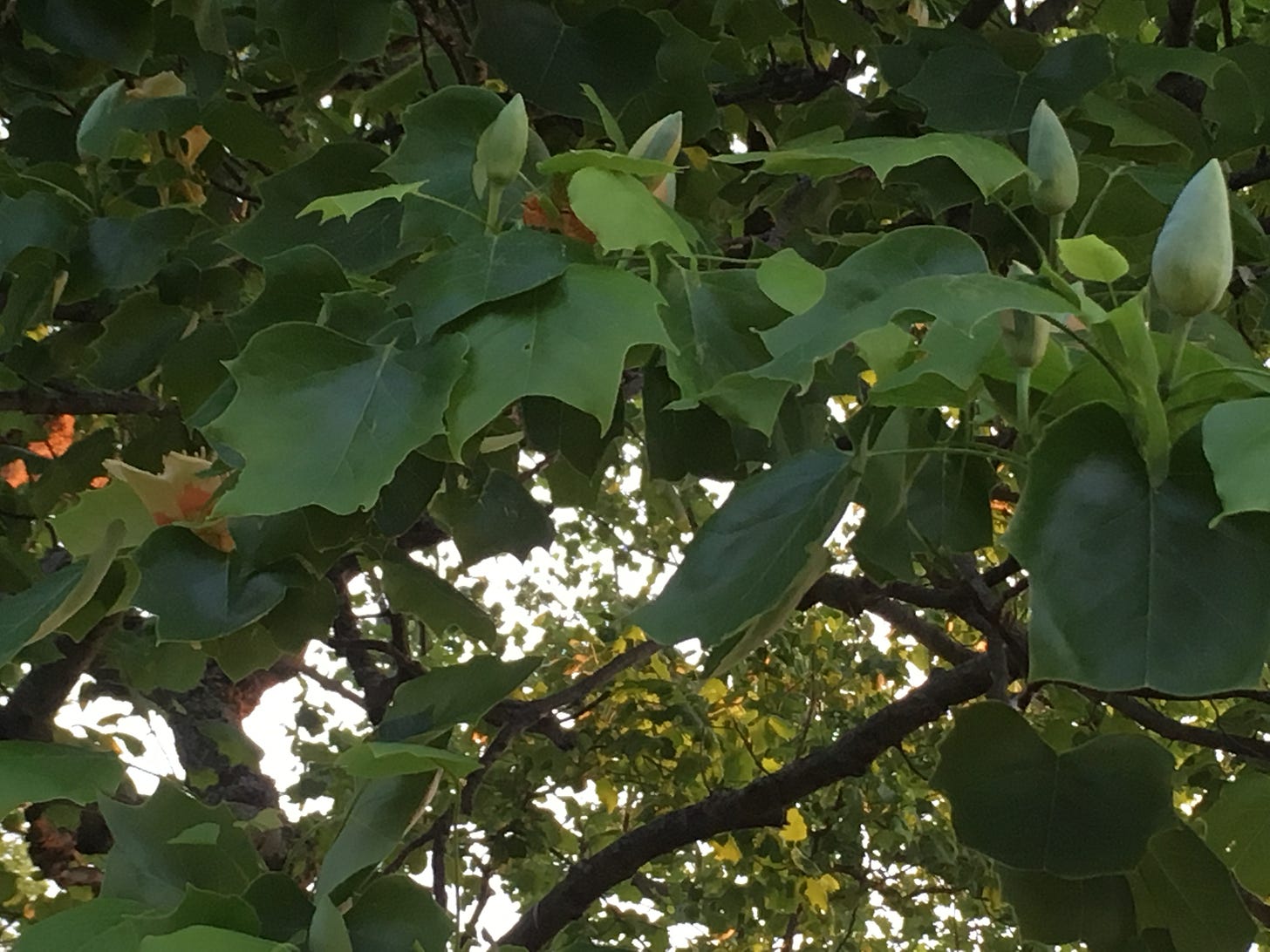One of North America’s biggest weeds is a poplar that’s not really a poplar, and it’s packed full of mostly undiscovered medicine. Our confidence in this is based upon it’s sheer size, longevity and the evidence available to smellavision. At weedom, there are some wind beaten tulip poplars along the driveway which will never reach maximum height, due to harsh conditions at one of the highest elevations of our county. We’ve replaced a few trees recently, and trimming low branches from a younger poplar, nearest to the road, is what inspired this article. We’ve seen the biggest and best tulip poplars in forested Smokey Mountain area where Kentucky and Tennesee meet. The tops of those trees fade in the distance. They dwarf our own trees, which are by no means small.
No tree exceeds 50 meters ( 100-190 feet heights), and 250-450 years of age without an impressive array of defensive chemistry, and to us, that means medicinal potential. It puts out vast, impressive, bug attracting blooms, literally dripping with nectar, and holds them out of your reach. This naturally self-pruning tree usually reaches such height by the time it first blooms, that you can only access a tiny fraction of its floral output. Enough nectar collects in the flowers that it splashes out and leaves sticky spots on nearby leaves. At optimal times, there’s enough that you could sip some from a bloom. Pick the bugs out first. Breaking the young branches or twigs, and similar sized roots elicits an aromatic blend of 5x lemon/lime/orange peels plus some indescribable spice. The best taste and aroma from branches is available in the spring, so the time to get to know this tree is starting now.
The Tulip poplar, Liriodendron tulipifera, of the Magnolaceae, (yaaaaa, it’s really a ginormous magnolia, not a poplar) is spreading from North America to other countries, because it’s a cool tree. Fortunately those people are avidly looking into the chemistry, which we’ll get back to in a bit.
It’s pretty easy to find this tree its native eastern 2/3 of the U.S., and it exists by now within most of the states, according to more recent maps of its distribution, mainly within USDA hardiness zones 4 thru 9. The leaf of the tulip poplar is like no other. Some liken its squarish, 4 lobed shape to a full-on outline of a cat face. Some see the profile of a tulip bloom. The upper side is a matte gloss green, and the underside is a lighter green. The smooth leaf petioles are 2-4 inches (5-10 cm.) long and the leaves vary in size reaching up to 6-8 inches (15-20cm.) wide. Smaller veins clearly arise from a well defined central vein on the leaves, which is not really the palmate venation that is mentioned in many botanical descriptions. Part of the leaves of Tulip poplars typically turn yellowish and drop in August. The remainder of the leaves may hang on for another six weeks or more, turning a bright yellow, then leaving the tree naked around the same time as the black walnut trees.
In May 2-3 inch, green buds give way to those tulip-looking blooms which dump pollen that coats our driveway and any vehicles parked thereon. Any light rain will leave strange patterns in the yellow dust.
These tulip shaped blooms are a striking mix of orange yellow and green, with a crowd of male stamens surrounding cone shaped fused pistils in the center. Their 6 petals form a cup which can hold a puddle of accumulated nectar. Beetles, bees, and butterflies, hummingbirds, squirrels, etc. visit these blooms, which later give way to a cone of fused samara, that persists into the winter. The million or so samara which are 1 winged seeds, up to 2 inches long, are gradually blown off onto the ground during the cold months. This leaves additional poke and slice for those of us who sometimes venture out barefoot in the spring. Even with mere 10 percent seed viability, the weed potential of poplar is impressive. We’re pulling little trees out of the landscapes and gardens incessantly.

At this time of year, poplar stems have a characteristic flattened bud which is split along the narrowest side, reminding many of a duck’s bill. The youngest part of the stem is a reddish green color, giving way to fairly grey with sparse lenticles (openings for air exchange) on the older parts. Splitting the twigs reveals a distinctly yellowish inner bark. As the tree ages, the smooth bark forms flat topped ridges which deepen in color. The furrows tend to retain a lighter color than the ridges. From a distance, tulip poplars in a forest or stand are noted by very straight trunks which lose their lower branches naturally in the shade of the canopy. This self pruning occurs more slowly on the well separated trees at weedom, but we are still wary of the process which leaves fairly large branches on the ground after high winds. The lowest branches on a full sized tulip poplar might emerge at a height of 50 feet or more.
If you ever need to start a fire in the primitive way, scrape some bark from old fallen branches of this tree. It forms a woody fluff that’s probably third only to pine needles and dryer lint in the ability to catch a spark and ignite. This fluff has also been used for personal insulation from the cold.
Most western herbalists seem less confident, than eclectic pharmacist, John Uri Lloyd, that good medicine resides in the tulip poplar. Matthew Wood is the standout, as he seems willing to listen to everyone when it comes to phytotherapy. Accordingly, he has picked up a good deal on use of this tree in folk medicine. He noted that the pioneers used it for chills, fever, exhaustion from malarial disease. The bark was mixed up with that of dogwood, cherry trees as a substitute for quinine for malaria. Matthew Wood charactarizes the bark as sweet and acrid, and specifies it to address the body is worn out by tension and sympathetic excess. Two of Matthew Woods’ herbalist colleagues of the Cherokee band told him that it’s a heart strengthening tonic. Similar claims had also been taken up by John Uri Lloyd, who extracted an alkaloid substance called tulipiferine. Some of this was handed over to Roberts Barthalow, who used this substance on frogs, and found that they would convulse, then finally enter a relaxed, immobile state, but that their hearts would continue pumping in a very slow, strong rhythm. He also determined experimentally that the motor relaxant effects were likely central in origin.
Digging around in the Native American Ethnobotany Database gives a list of the traditional folk uses. In the Northeast the Rappahannock were using the raw green bark as a stimulant or sex performance enhancer, and they would apply a poultice of bruised leaves to the head for neuralgic pain. Cherokees used twig bark or bark infusion to treat parasitic worms, dysentery, cough, rheumatism, as sedative, and as a poultice for wounds. Root bark served as a febrifuge, and “honey” as a condiment or food. This latter use would need to have occurred after Europeans brought the honey bees. Another possible explanation, offered by ‘Green Deane’ Jordan, is that the Cherokees were using the nectar from the blossoms earlier on. In present times, the tulip poplar blooms are recognized to supply an abundance of starting material for a flavorful type of honey, for hives which are strong enough in spring to access the blooms.
The Chinese have their own Liriodendron chinense, and they’re studying it as well as our tulipifera. They’re looking at the phenylpropanoid biosynthetic pathways within the blooms of the Chinese and American species. These pathways lead to innumerable secondary metabolites, including flavonoids, lignans, anthocyanins, and organic acids , which are of adaptive and protective significance to plants and of use to us. Of interest is chlorogenic acid production, which is produced by various pathways in plants and other eukaryotes, and, of course it’s found in our Liriodendron blooms too. This molecule is a free radical scavenger, anti-oxidant which serves to protect cells from becoming cancerous, and allows them to resist viral infection. (Lately chlorogenic acid has been credited with protecting coffee drinkers from COVID.)
Investigations into the anti-malarial effects of Tulip poplar bark have yielded, numerous aporphine alkaloids with significant anti-plasmodial activity, giving credence to the folk usage for malaria. In addition, two sequiterpene lactones with anti-plasmodial activity have been found in the leaves. A noraporphine allkaloid called norstephalagine, found in the leaves, has shown relaxant activity on rat uterine smooth muscle. Some of the sesquiterpene lactones obtained by hydrodistllation of leaves, flowers, fruits have been found to have cytotoxic activity against melanoma and various other cancer cells. Laurenobiolide, a sesquiterpene lactone from the twigs of the tulip poplar has shown potent activity against Staph aureus (MSSA), such that dropping a twig piece on an agar plate produces a zone of inhibition. The MIC of 7.8 micrograms/ml compared favorably with that of the antibiotic, gentamicin sulfate (6.3 micrograms/ml).
Get friendly with your trees! You likely can’t find one without numerous medicinal gifts, many of which are accessible year round.
and are also writing about medicinal trees on SubStack, and you’re encouraged to check them out.Which trees are you using for food or medicine? Let us know your favorites.
We won’t do a regular post for a week or two, due to home business, and preparing the nerd power for some in person presentations :-D Full strength weedom will return to accompany your spring wanderings. Be sure to check out weedom archives of Spring 2023 especially if you haven’t seen those yet.
Yessss, our spring peepers are sounding so good.
Where We Dig
1. Kang YF, Liu CM, Kao CL, Chen CY. Antioxidant and Anticancer Constituents from the Leaves of Liriodendron tulipifera. Molecules. 2014;19(4):4234-4245. doi:10.3390/molecules19044234
2. Graziose R, Rathinasabapathy T, Lategan C, et al. Antiplasmodial activity of aporphine alkaloids and sesquiterpene lactones from Liriodendron tulipifera L. Journal of Ethnopharmacology. 2011;133(1):26-30. doi:10.1016/j.jep.2010.08.059
3. Doskotch RW, El-Feraly FS. Antitumor agents. IV. Structure of tulipinolide and epitulipinolide. Cytotoxic sesquiterpenes from Liriodendron tulipifera L. J Org Chem. 1970;35(6):1928-1936. doi:10.1021/jo00831a046
4. Chiu CC, Chou HL, Wu PF, Chen HL, Wang HM, Chen CY. Bio-Functional Constituents from the Stems of Liriodendron tulipifera. Molecules. 2012;17(4):4357-4372. doi:10.3390/molecules17044357
5. Hu L, Yu L, Weng Y, et al. Combined non-targeted metabolomic and transcriptomic analysis explains the biosynthetic pathway and differential accumulation of chlorogenic acid in the Liriodendron petal. Scientia Horticulturae. 2024;328:112791. doi:10.1016/j.scienta.2023.112791
6. Jordan D. Eat the Weeds: A Forager’s Guide to Identifying and Harvesting 274 Wild Foods. Adventure Publications; 2023.
7. ENH-522/ST363: Liriodendron tulipifera: Tuliptree. Ask IFAS - Powered by EDIS. Accessed February 28, 2024. https://edis.ifas.ufl.edu/publication/ST363
8. Quassinti L, Maggi F, Ortolani F, et al. Exploring new applications of tulip tree (Liriodendron tulipifera L.): leaf essential oil as apoptotic agent for human glioblastoma. Environ Sci Pollut Res Int. 2019;26(29):30485-30497. doi:10.1007/s11356-019-06217-4
9. Quassinti L, Maggi F, Ortolani F, et al. Exploring new applications of tulip tree (Liriodendron tulipifera L.): leaf essential oil as apoptotic agent for human glioblastoma. Environ Sci Pollut Res Int. 2019;26(29):30485-30497. doi:10.1007/s11356-019-06217-4
10. In traditional medicine the Tuliptree has many uses. Cape Gazette. Accessed February 27, 2024. https://www.capegazette.com/node/184286
11. Liriodendron tulipifera (Canary Whitehood, Canoewood, Lyre Tree, North American Whitewood, Tulip Poplar, Tulip Tree, Western Poplar, Whitewood, Yellow Poplar, Yellow-Poplar) | North Carolina Extension Gardener Plant Toolbox. Accessed February 27, 2024. https://plants.ces.ncsu.edu/plants/liriodendron-tulipifera/
12. Liriodendron tulipifera (Tulip Tree) - Practical Plants. Accessed February 27, 2024. https://practicalplants.org/wiki/liriodendron_tulipifera/
13. Liriodendron tulipifera Tulip Tree, Tulip Poplar, Yellow Poplar, Canary Whitewood PFAF Plant Database. Accessed February 27, 2024. https://pfaf.org/user/Plant.aspx?LatinName=Liriodendron+tulipifera
14. Lloyd and Lloyd, 1884-1887: Drugs and Medicines of North America. | Henriette’s Herbal Homepage. Accessed February 28, 2024. https://www.henriettes-herb.com/eclectic/dmna/index.html
15. Kirk RD, Rosario ME, Oblie N, et al. Screening the PRISM Library against Staphylococcus aureus Reveals a Sesquiterpene Lactone from Liriodendron tulipifera with Inhibitory Activity. ACS Omega. 2022;7(40):35677-35685. doi:10.1021/acsomega.2c03539
16. Wood M. The Earthwise Herbal. A Complete Guide to NEw World Medicinal Plants. North Atlantic Books; 2009. https://openlibrary.org/books/OL22552057M/The_earthwise_herbal.
17. Taylor WI. The structure and synthesis of liriodenine, a new type of isoquinoline alkaloid. Tetrahedron. 1961;14(1):42-45. doi:10.1016/0040-4020(61)80085-9
18. Tulip Poplar. Medicinal Herb Info. Accessed February 27, 2024. http://medicinalherbinfo.org/000Herbs2016/1herbs/tulip-poplar/










Thank you @Weedom1 for guiding me into a world I can only see from the outside. I know so little about trees and your posts are like being introduced to a neighbor who speaks a different language. I admit to being startled by some of the science ... "A noraporphine allkaloid called norstephalagine, found in the leaves, has shown relaxant activity on rat uterine smooth muscle."
For some reason, that just makes me wonder at the interconnected web of life ... why would a tree manufacture a substance that has an effect on a rat uterus ... and how did science come to explore the two? So awfully many questions.
Great article! I have to take out two on my property this spring and I will try my hand at making baskets from the inner bark.